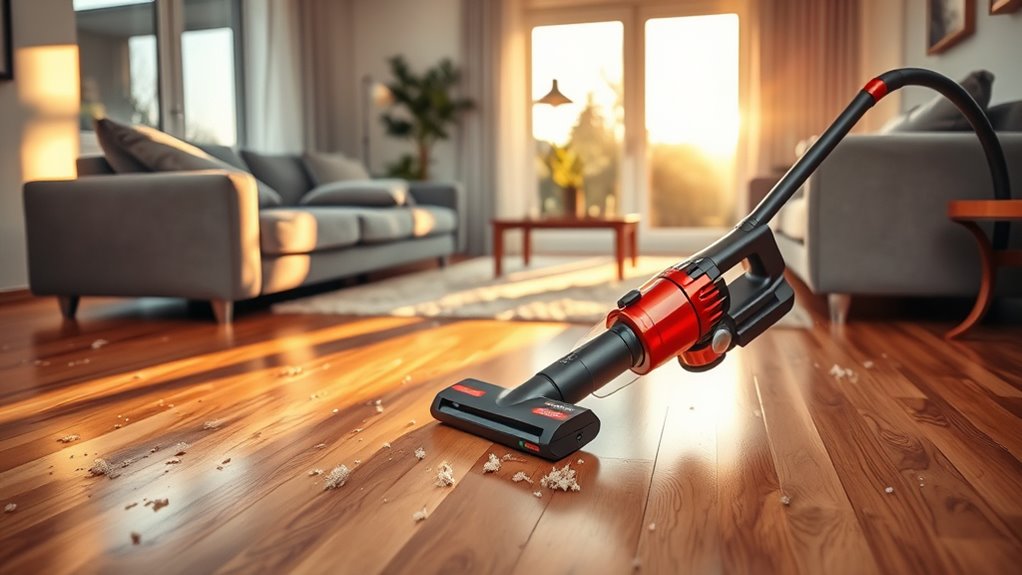To do a quick vacuum sprint before dinner, start by evaluating your space and gathering essentials like microfiber cloth and attachments. Clear clutter from high-traffic areas, focus on entryways and living zones, and set your vacuum to the right settings for a speedy clean. Use efficient techniques like overlapping passes and spot clean problem areas. Manage cords with clips or ties for a neat finish. Keep your vacuum maintained so your quick refresh is effortless—if you keep going, you’ll discover even more time-saving tips.
Key Takeaways
- Prepare essentials and clear clutter to ensure a swift, uninterrupted vacuum session.
- Focus on high-traffic zones like entryways and living areas for maximum impact.
- Adjust vacuum settings for quick, effective cleaning on different surfaces.
- Use attachments or handheld tools to target pet hair and spots efficiently.
- Set a timer to keep the vacuuming brief, maintaining momentum before dinner.
Assessing Your Space and Gathering Supplies

Before you begin your mid-week reset, it’s important to evaluate your space and gather all the supplies you’ll need. Start by checking your vacuum’s condition and performing basic vacuum maintenance, like cleaning the filter and emptying the bin. Ensuring your vacuum functions properly will make your cleaning more effective. Review your cleaning schedule to identify high-traffic areas that need extra attention this week. Gather essentials such as a microfiber cloth, dusting brush, and any specialty attachments you might need. This prep helps you work efficiently, avoiding interruptions during your quick vacuum sprint. Taking a few minutes to assess your space and supplies streamlines your cleaning process, making your mid-week reset quicker, easier, and more thorough.
Clearing the Area for Efficient Cleaning
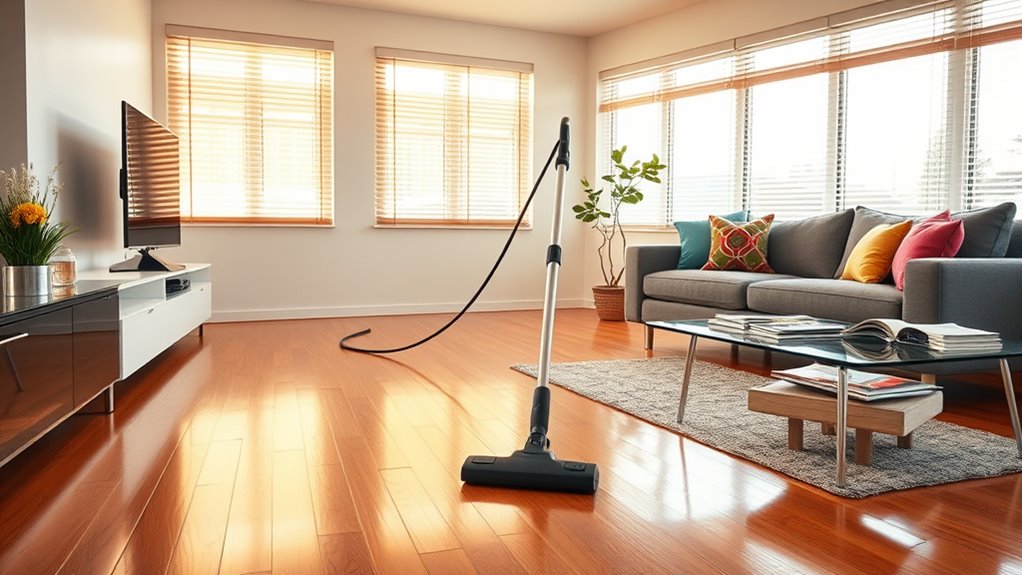
Clearing the area before you start cleaning guarantees you work quickly and effectively. Start by removing clutter to avoid tripping or missing spots. Next, focus on furniture clearance by moving pieces away from the floor, making vacuuming easier. Make sure any small objects, like toys or magazines, are picked up and put aside. Finally, tidy up surfaces to reduce dust accumulation and create a clear workspace. Incorporating automation technology can further streamline your cleaning routine and optimize efficiency.
Prioritizing High-Traffic Zones
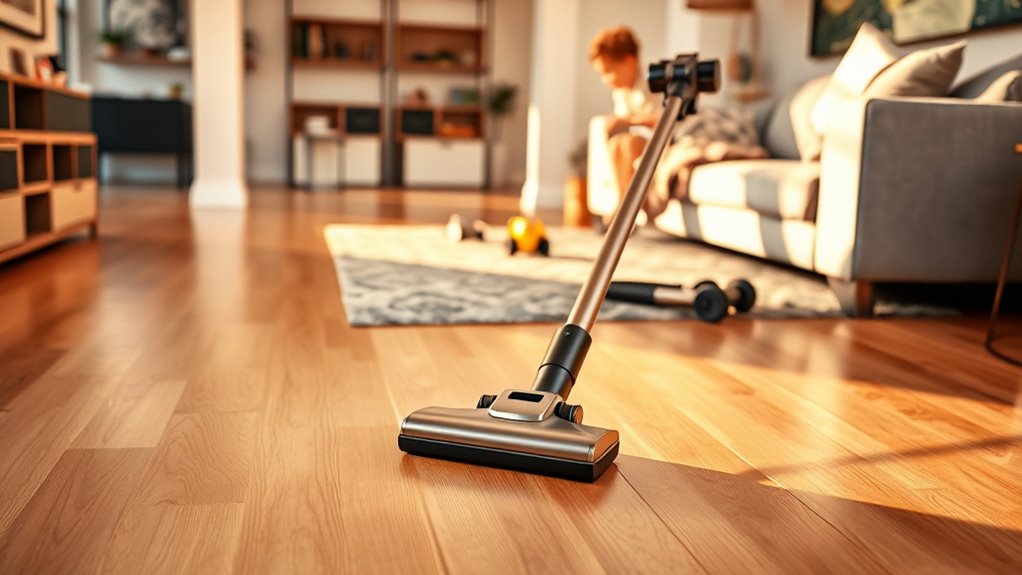
Start by focusing on entryways, since they see the most foot traffic and set the tone for your space. Then, move into living areas to quickly make your home feel more inviting. Finally, prioritize kitchen spots, as they’re essential for daily routines and often get the messiest. To maximize comfort during these quick cleanups, consider using a mattress topper to enhance your sleep environment and add a layer of support.
Focus on Entryways
Why should you prioritize entryways when resetting your space? Because they’re the first impression visitors see and often the most used area daily. A clean entryway sets the tone for your entire home and keeps dirt from spreading. Focus on decluttering, vacuuming the floor, and tidying seasonal decorations to keep it inviting. Consider updating entryway decor to match the season for a fresh look. Here are some quick tips:
- Clear out unnecessary items and shoes.
- Vacuum or sweep the entry floor thoroughly.
- Refresh seasonal decorations for a welcoming vibe.
- Organize hooks and shelves for easy access.
Tackle Living Areas
Since high-traffic zones naturally experience more wear and mess, focusing your reset efforts on these areas can make a noticeable difference in maintaining a tidy home. Regular vacuuming in living areas helps prevent dirt buildup and keeps floors looking fresh. To stay efficient, stick to a cleaning schedule that targets these busy spots at least mid-week. Remember, proper vacuum maintenance guarantees your machine works effectively, making quick cleanups easier. Clear clutter before vacuuming to maximize efficiency and avoid scattering debris. Pay special attention to entry points, pathways, and seating areas, where dust and crumbs tend to accumulate. Incorporating home hygiene practices can further enhance the cleanliness and reduce allergens in your living spaces. This focused approach keeps your living spaces inviting and reduces the need for deeper cleanings later. A quick vacuum sprint now saves you time and effort later.
Prioritize Kitchen Spots
Focusing on high-traffic spots in your kitchen keeps clutter and mess under control where it counts most. Prioritize areas like the sink, stove, countertops, and entryways. These zones see the most foot traffic and mess, so they deserve your quick vacuum attention. To keep your vacuum performing well, stick to regular cleaning schedules and vacuum maintenance. This helps prevent issues like clogged filters that can reduce suction power. Here are four tips:
- Vacuum high-traffic zones daily or every few days.
- Clear debris before vacuuming for better suction.
- Check and maintain your vacuum regularly.
- Focus on areas prone to crumbs and spills for maximum impact.
Quick, targeted vacuuming keeps your kitchen tidy without taking up much time.
Choosing the Right Vacuum Settings for Quick Results
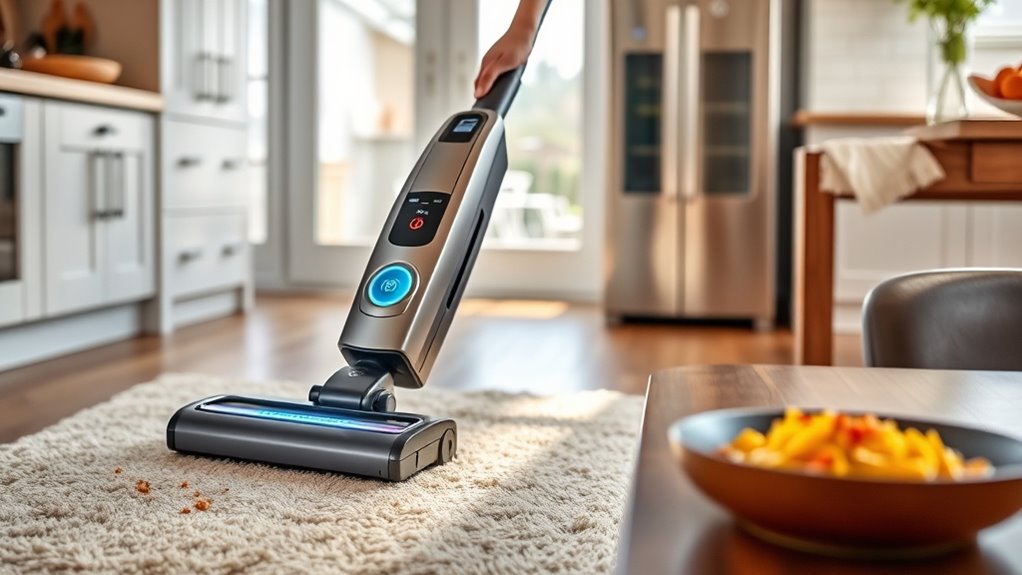
Choosing the right vacuum settings can make all the difference when you need quick, effective cleaning. Adjusting vacuum suction guarantees you pick up debris efficiently without wasting time. For quick cleans, lower suction levels work well on hard floors, saving power and reducing noise. The brush roll speed also matters; setting it to a medium or high speed helps lift dirt quickly on carpets and rugs. If you’re dealing with lightweight dust or pet hair, turn the brush roll down or off to avoid scattering debris. Always start with a moderate setting and adjust based on the surface and debris type. Properly selecting these settings ensures you get a thorough clean fast, without unnecessary effort or fuss.
Using Efficient Techniques for a Fast Clean

To clean efficiently and save time, plan your approach before you start vacuuming. A quick review of your cleaning schedule helps identify high-traffic areas needing priority. Keep your vacuum in good shape through regular vacuum maintenance to prevent delays during cleaning. Use efficient techniques like overlapping passes and adjusting suction settings for different surfaces.
Here are four tips for a fast clean:
- Focus on high-traffic zones first.
- Clear clutter to avoid interruptions.
- Use quick passes rather than deep cleaning.
- Empty the vacuum bag or bin regularly for maximum suction.
Following these steps ensures you maximize your cleaning time without sacrificing results. Staying on a consistent cleaning schedule and maintaining your vacuum makes each quick session more effective.
Incorporating Spot Cleaning for Problem Areas
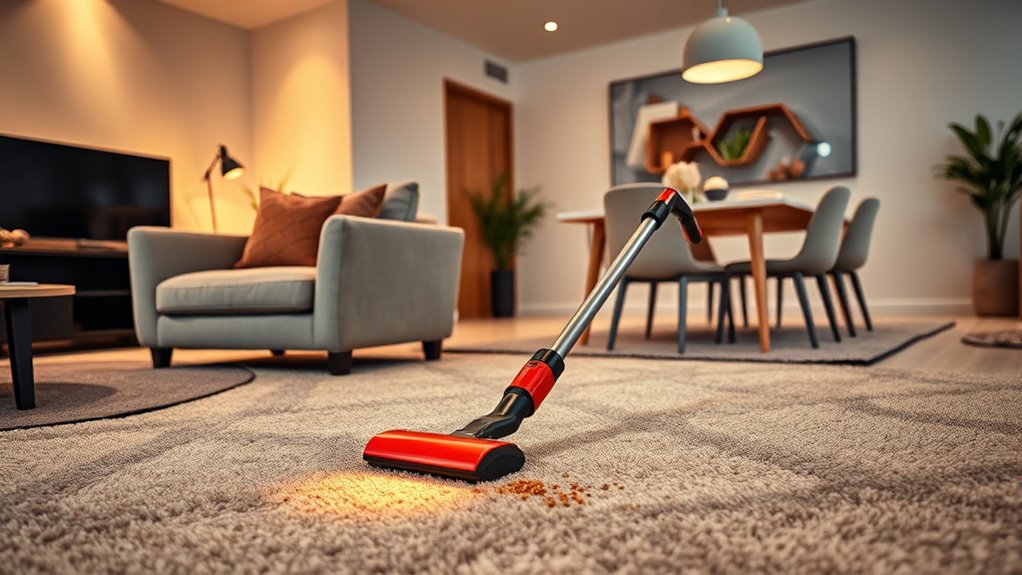
Even with regular cleaning, certain spots tend to accumulate dirt or stains more quickly, making targeted spot cleaning essential. Focus on areas where pet hair gathers or stains appear, such as around furniture or high-traffic zones. Use a handheld vacuum or attachment to quickly target these problem spots, saving time and effort. For pet hair, a rubber broom or lint roller can be surprisingly effective before vacuuming. Spot cleaning also helps with allergen removal by removing dust, pet dander, and dirt from specific areas, reducing allergens in the air. Addressing these problem areas mid-week prevents buildup and keeps your space fresher. Incorporating quick spot cleanings into your routine can significantly improve indoor air quality and maintain a cleaner environment without overhauling your entire cleaning schedule.
Managing Cord and Cable Clutter
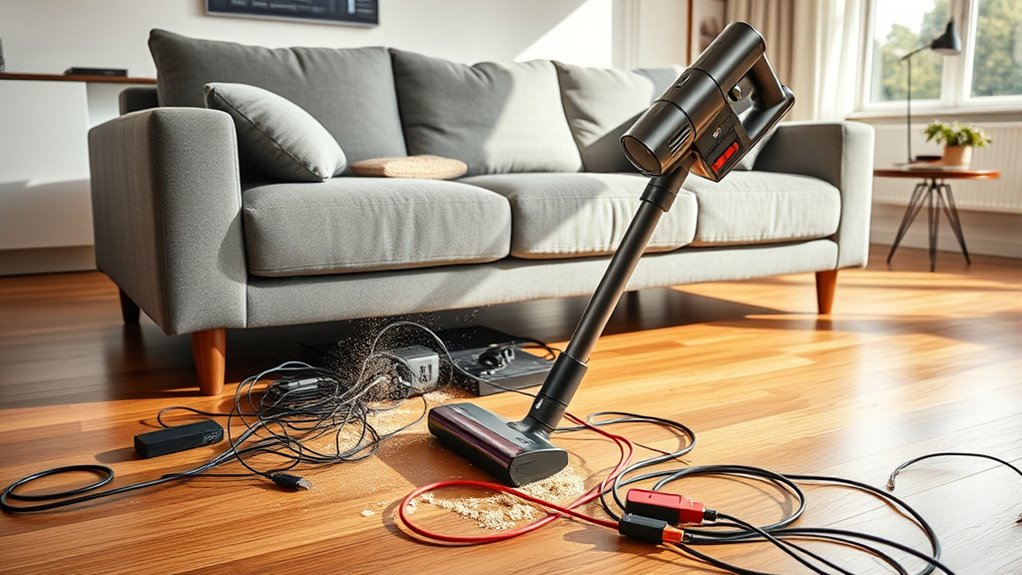
Tangled cords and cables can quickly turn your space into chaos. Using simple cord clips and storage solutions helps keep everything neat and accessible. With these tips, managing your cables becomes quick and hassle-free. Additionally, utilizing organized power sources can streamline your setup and reduce clutter further.
Cable Organization Tips
Managing cable and cord clutter can considerably improve your space’s organization and functionality. It makes cleaning easier and reduces hazards. To optimize your cable management, try these tips:
- Use cable ties or velcro straps to bundle cords together neatly.
- Label cords with tags or masking tape to identify devices quickly.
- Store excess cable length in a coil or designated box to avoid tangles.
- Invest in organizing accessories like cable clips or sleeves to keep everything tidy.
- Be aware of privacy policy implications when storing and managing electronic cords connected to smart devices.
Using Cord Clips
Using cord clips is a simple and effective way to keep your cables organized and prevent them from slipping or falling behind furniture. They help you manage cable clutter by securing cords along edges, under desks, or along walls. With a few clips, you can avoid tangled wires and easily identify each cord when needed. Attach the clips to strategic spots, like behind your desk or TV stand, to keep cords neatly in place. This improves safety by reducing tripping hazards and makes cleaning quicker. Cord clips are versatile and work with various cable types, from charging wires to appliance cords. Incorporating them into your cable management routine streamlines your space and saves you time untangling or searching for misplaced cords. Additionally, using cable organization tips can further optimize your setup and maintain a tidy environment.
Storage Solutions
Are your cables taking over your space? It’s time to organize with effective storage solutions. Use storage bins to contain loose cords and keep them out of sight. Incorporate closet organizers to create dedicated compartments for chargers, extension cords, and gadgets. Here are some ideas to get started:
- Label each cable and store it in labeled storage bins.
- Use cable ties or velcro straps to bundle cords neatly.
- Install hooks or clips inside closet doors for quick access.
- Dedicate a drawer or shelf with dividers for smaller accessories.
These strategies help reduce clutter, making your space cleaner and more functional. With a little effort, your cords will stay organized and ready when you need them.
Setting a Timer to Stay on Track
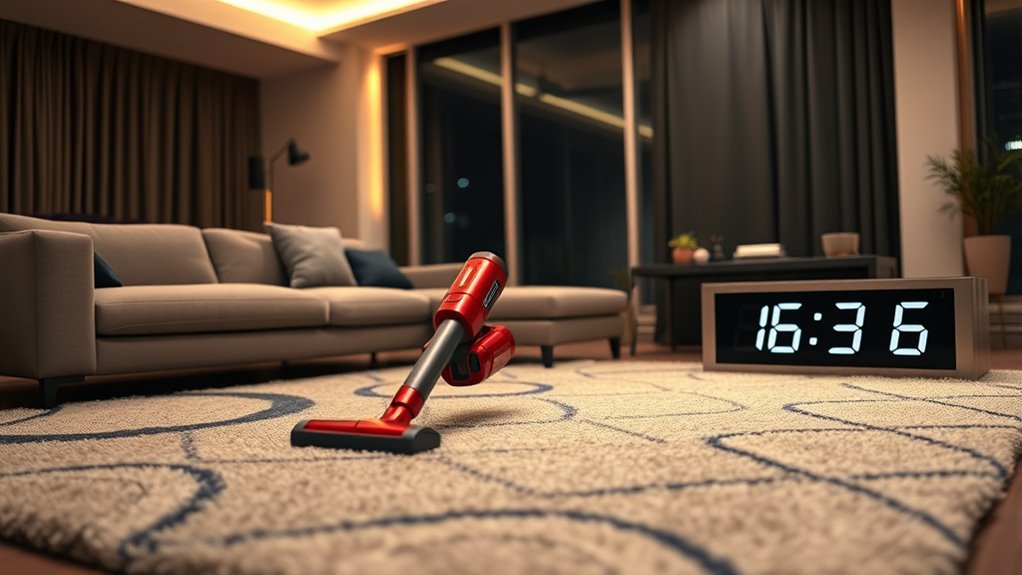
Setting a timer is one of the simplest yet most effective ways to stay focused and on track during your mid-week reset. When you set a timer, you prevent your cleaning session from dragging on and guarantee you stick to your cleaning schedule. This helps maintain your vacuum’s performance by encouraging timely vacuum maintenance and avoiding neglect. A short, focused burst of cleaning keeps your floors fresh without feeling overwhelming. Use your timer to allocate specific minutes for vacuuming, making it easier to stay disciplined. Once the timer rings, you know it’s time to stop, reassess, and prepare for the next clean. This simple step keeps you efficient, maintaining a consistent cleaning routine that keeps your home tidy and your vacuum in top shape. Additionally, being mindful of coastal erosion and other environmental factors can help you better understand natural processes that impact beach environments.
Resetting and Maintaining Your Vacuum for Next Use
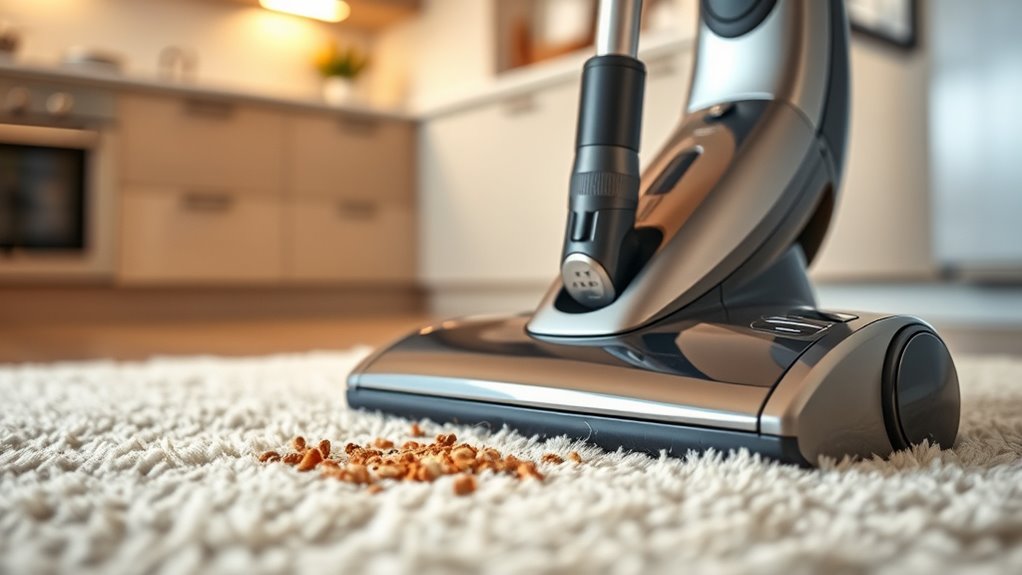
To make certain your vacuum works efficiently for the next cleaning session, it’s crucial to reset and maintain it properly after each use. Regular vacuum filter maintenance ensures ideal airflow and suction power. Additionally, caring for the battery helps prolong its life and keeps your vacuum ready on demand. Here are four essential steps: 1. Remove and clean or replace the vacuum filter regularly. 2. Empty the dustbin or replace bags to prevent clogs. 3. Check the battery’s charge level and recharge if needed. 4. Store your vacuum in a cool, dry place to prevent battery degradation. Regular maintenance and proper storage prevent costly repairs and keep your vacuum functioning at peak performance.
Frequently Asked Questions
How Often Should I Perform a Quick Mid-Week Vacuum?
You should perform a quick mid-week vacuum to maintain your cleaning schedule and prevent dust buildup. Regular vacuum maintenance helps keep your home fresh and allergen-free. Doing this every 3 to 4 days guarantees carpets and floors stay tidy without overwhelming your routine. A mid-week vacuum is a simple way to stick to your cleaning schedules, keeping your space clean, comfortable, and inviting with minimal effort.
Can I Vacuum on Hardwood or Delicate Floors Quickly?
Yes, you can vacuum quickly on hardwood or delicate floors, but you should prioritize vacuum maintenance and use a gentle settings or a soft-bristled attachment. This helps protect your floors from scratches and keeps them looking their best. Move smoothly and avoid excessive pressure, ensuring effective cleaning without damage. Regular quick vacuuming supports hardwood care by removing dust and debris that can cause wear over time.
What’s the Best Way to Prevent Vacuum Cord Tangles?
Think of your vacuum cord like a garden hose—if it’s tangled, nothing flows smoothly. To prevent cord tangles, practice good cord management by neatly winding the cord after each use. Use a cord extension if needed, so you don’t strain or pull on the cord. Keep the cord off the floor when not in use, and avoid twisting or jerking it while vacuuming. These tips keep your vacuum running seamlessly.
How Do I Handle Pet Hair During a Quick Clean?
When handling pet hair during a quick clean, focus on effective hair pickup by adjusting your vacuum settings or using a brush attachment designed for pet hair removal. Keep the vacuum’s brush roll clean and unclogged to improve suction. For stubborn hair, go over areas multiple times, especially around furniture and pet resting spots. This guarantees you efficiently remove pet hair and maintain a tidy space without extra effort.
Is It Necessary to Deep Clean My Vacuum Regularly?
Like a gardener tending to their roses, you need to care for your vacuum through regular maintenance. Deep cleaning your vacuum isn’t always necessary, but establishing a consistent cleaning schedule ensures it functions efficiently. Over time, dust and debris can clog filters and brushes, reducing its power. By performing routine vacuum maintenance, you keep your device in top shape, making quick cleans like your mid-week reset smoother and more effective.
Conclusion
Even on busy nights, a quick vacuum doesn’t have to feel overwhelming. With a focused approach, you can tackle high-traffic areas fast and keep your space tidy without sacrificing your evening. Don’t think you need a deep clean every time—small, consistent efforts make a big difference. Just set your timer, stay efficient, and remember, a little vacuuming now saves you more time later. You’ve got this—your home will thank you!

